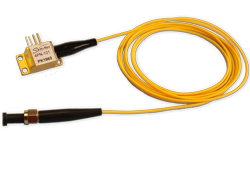SemiNex laser diodes leave Earth in 2014
Peabody, Mass. – December 9, 2014 –Fiber coupled laser diodes manufactured by SemiNex Corporation recently completed a mission to the International Space Station. Two SemiNex 4-Pin lasers were used in LiDAR systems for navigation and range finding. The lasers performed flawlessly and returned to Earth following the flight.

The SemiNex lasers were chosen for their rugged design and established long term reliability. SemiNex provides 4-Pin lasers at a variety of wavelengths; however, for this application, 1550 nm was chosen due to the “eye safety” requirements. This achievement was the culmination of an effort that started in August 2013, when the modules were first qualified for launch.
Prior to their maiden voyage, the lasers underwent extensive qualification testing. The qualification included approximately one hundred billion laser pulses over a three week period. Throughout testing, 100% of the packaged laser diodes performed as expected, with no degradation in performance. SemiNex founder and Chief Executive Officer David Bean said, “Having our off-the-shelf laser products perform well under such rigorous testing exemplifies our lasers’ high performance, quality and reliability.”
SemiNex’s lasers are also under evaluation and qualification for point-to-point, secure, space-based communications. Fiber-coupled devices, TO can-packaged devices and laser chips are all under consideration. SemiNex continues to work with its customers on engineering the most reliable, long-term solution for this new space application.
In addition to being deployed into space, SemiNex lasers are used in a host of applications, including range finding, LiDAR, targeting, telecommunications testing, and surgical procedures. Wavelengths used most commonly for these applications are between 1300 nm and 1650 nm.

